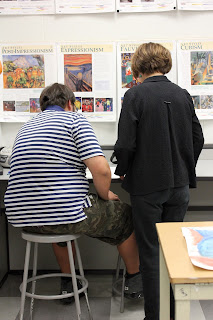Africa
1. I'm a big fan of Nick Brandt's work. I think his photography is beautiful, and I admire his patience to get the photos he wants. As I was reading his interview with ScientificAmerican.com, I found myself getting emotional. I agree with his views on Africa's wildlife, and how he's fascinated and obsessed with these animals. I think it's very upsetting that so many of these amazing animals are getting killed for people's own benefits.
3. This photo by Nick Brandt is a line of elephants walking together. This is my favorite photo by Brandt because it has a sense of family to it. The elephants are walking united, and it shows love. I also love the beauty of the elephants, and how he was able to capture it.
4. In this photo, Nick Brandt used leading lines and the rule of thirds. Leading lines is where you have a line throughout the photo leading up to your main subject. The rule of thirds is when your main subject, the elephant in the front, is off centered and in a third of the frame.
5. Nick Brandt uses a Pentax 67II without a telephoto or zoom lens. This is important to his photography because it means that he's getting close up to the animals in order to capture their emotions. Also, this way he can get more of the setting into his photos.
6. Nick Brandt's reason to take these photos of African wildlife are to memorialize the vanishing beauty of these animals. He wants to show people how amazing these animals really are before it's too late.
7. Nick Brandt takes these photos in hope that people will realize how great these animals are. He hopes that people will reach out and help the wildlife before it's too late. Brandt wants to encourage people to help and donate to charities to keep these animals alive.
8. "My images are unashamedly idyllic and romantic, a kind of enchanted Africa. They're my elegy to a world that is steadily, tragically vanishing." - Nick Brandt
Abandoned Theme Parks
1. I would like to visit the Six Flags, in New Orleans. I want to go to this theme park because it seems like it has a lot of things from the park have been kept in good condition. There's still a lot of the figures and rides in tact, and I think I could take a lot of creepy photos there.
3. The Myrtles Plantation, Louisiana; Highgate Cemetery, London; Convent of Saint Agnes, Prague; Saint Augustine Lighthouse, Florida; Eastern State Penitentiary, Philadelphia
Highgate Cemetery, London
5. I would be interested in taking photos at the Highgate Cemetery in London because cemeteries often creep people out. I think the uncomfortable feeling of cemeteries is what draws me to this location. I want to be able to capture the chilling sights of this cemetery. I would want people to see my photos and get uneasy about the setting of them. I'd expect to take a lot of backlit photos, like the one posted above, for a more dramatic photo.
6. If I were to actually go to this location to take photos, I would need some things. One would be better camera equipment with a tripod and multiple different lenses. My travel plan would probably be to fly to London, stay with my friend and her family who live there for a week, and go to the Highgate Cemetery everyday. In order to get the best photos I'm capable of, I'd go multiple days for long hours. I don't think I'd have to worry about many laws besides trespassing, I would just be worried to disturb other people and disrespect the loved ones of the people who have passed.
















